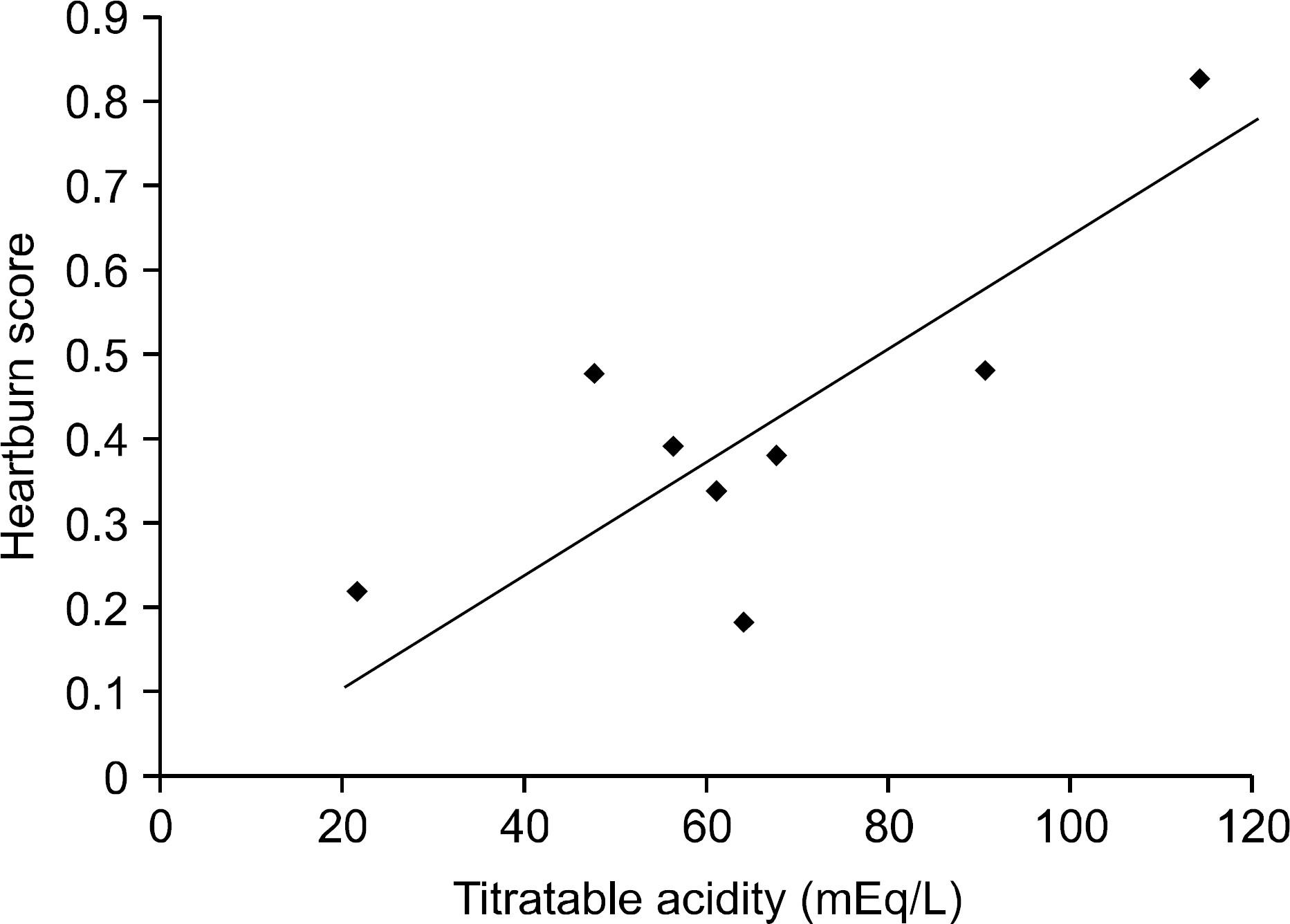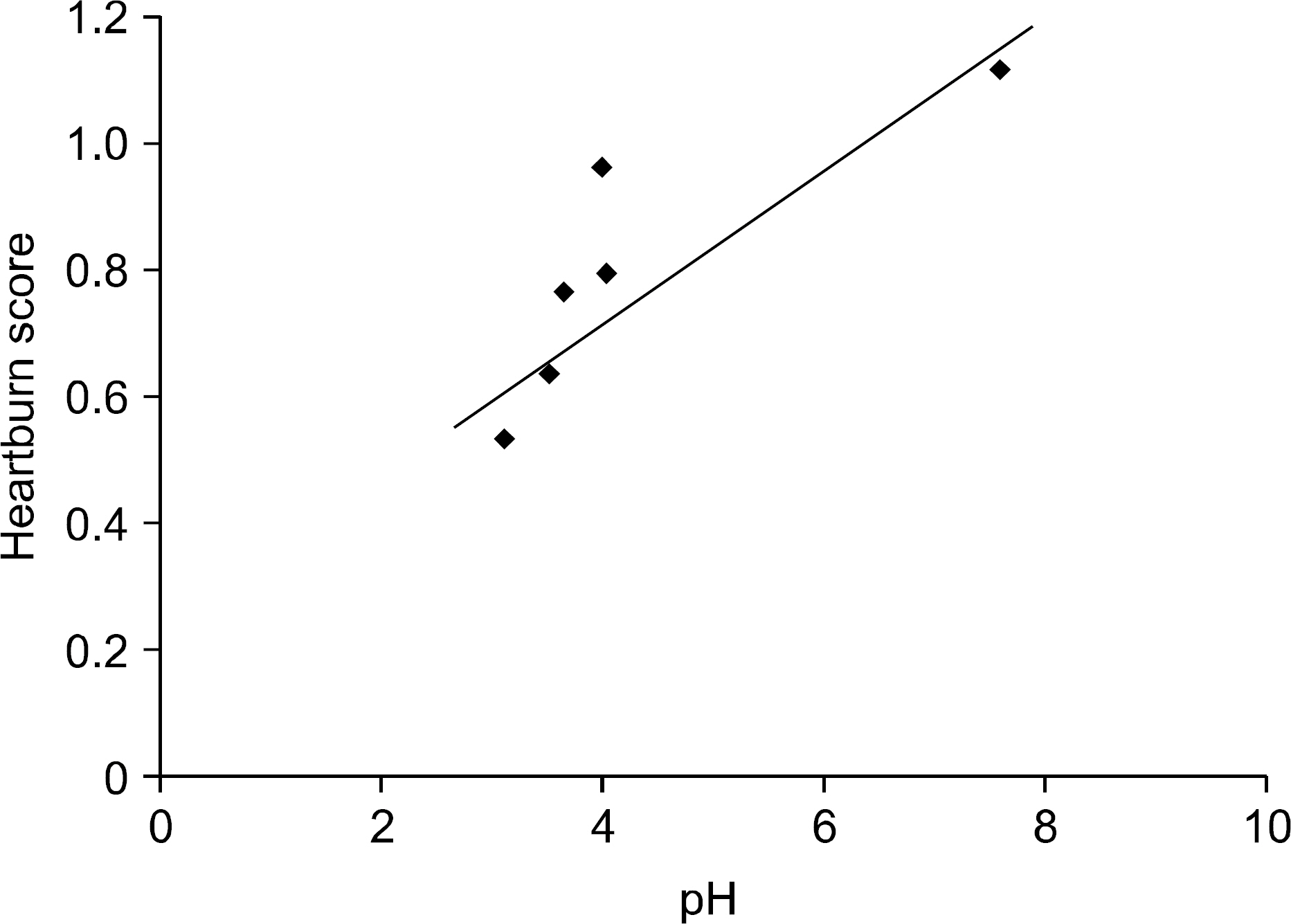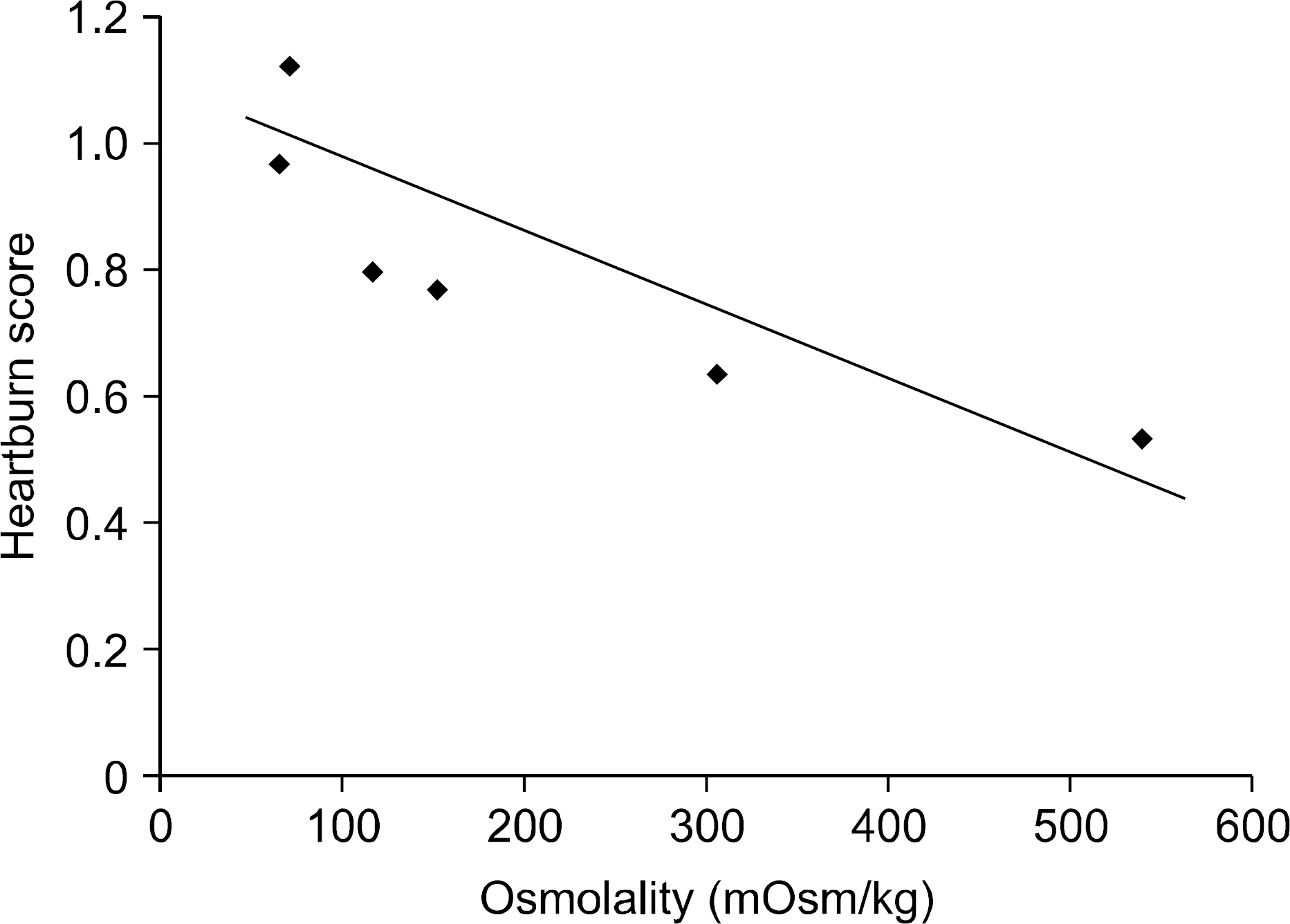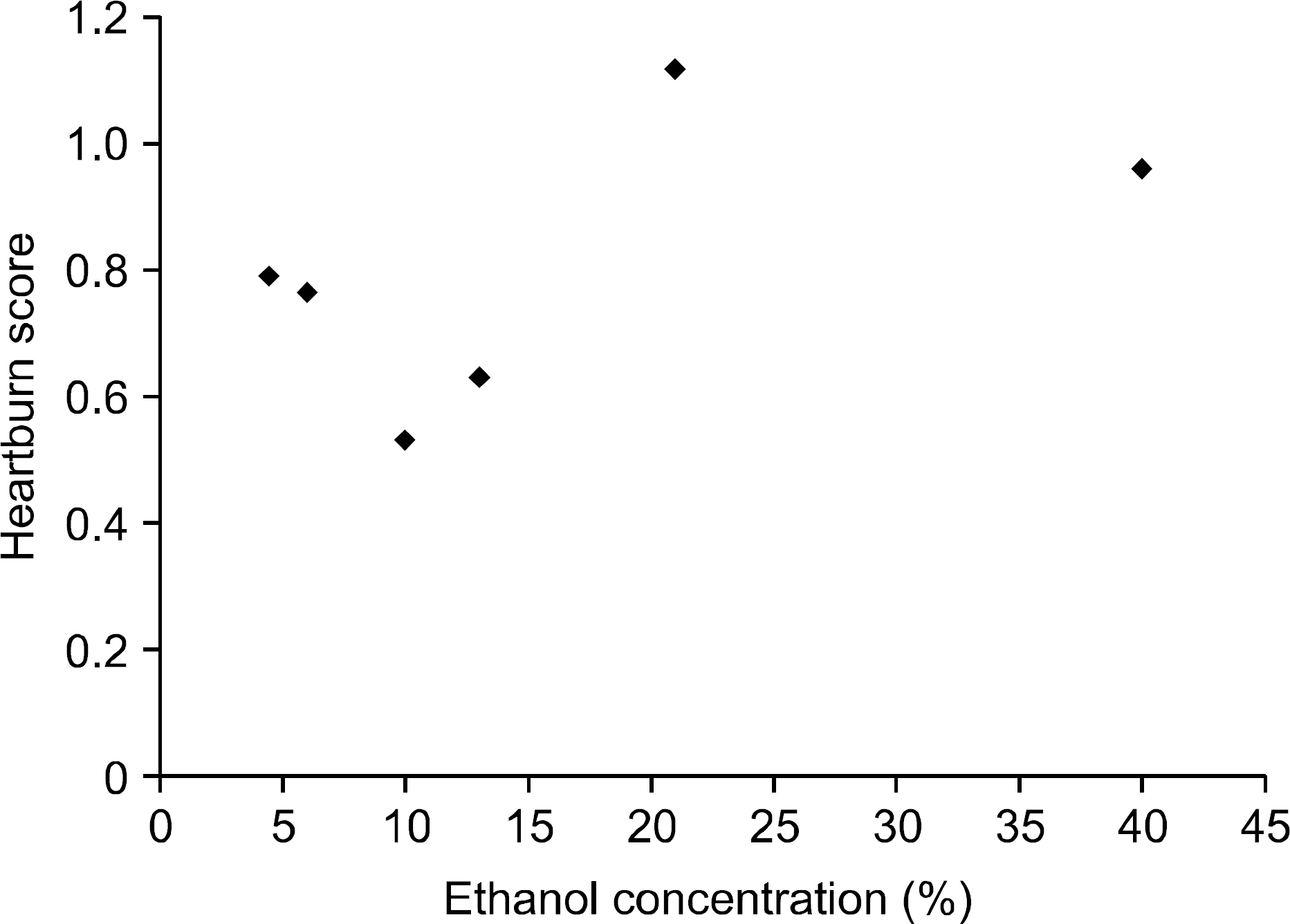Korean J Gastroenterol.
2010 Feb;55(2):109-118. 10.4166/kjg.2010.55.2.109.
The Relationship between the Popular Beverages in Korea and Reported Postprandial Heartburn
- Affiliations
-
- 1Department of Internal Medicine, Seoul Paik Hospital, Inje University College of Medicine, Seoul, Korea. moonjs2@unitel.co.kr
- KMID: 1718294
- DOI: http://doi.org/10.4166/kjg.2010.55.2.109
Abstract
- BACKGROUND/AIMS
The aim of this study was to investigate the frequency of heartburn produced by beverages available in Korea and to clarify the mechanism causing heartburn.
METHODS
We measured pH, titratable acidity, and osmolality of 35 beverages in vitro and correlated them with the severity of heartburn reported by questionnaire in 382 patients from November 2004 to June 2005.
RESULTS
Coffee (1.15) and soju (1.12) showed the highest heartburn score, while oolong tea (0.17) and carrot juice (0.18) showed the lowest heartburn score among all beverages. Titratable acidity of citrus juices correlated with heartburn (r=0.78; p=0.023). Soft drinks had the lowest pH, which was unrelated with heartburn scores (r=-0.54; p=0.460). Increasing pH among alcoholic beverages was correlated with heartburn scores (r=0.84; p=0.037), and osmolality was inversely associated with heartburn scores (r=-0.86; p=0.028). The heartburn score of decaffeinated coffee was significantly lower than that of regular coffee (p<0.001). Regular milk caused more heartburn than low-fat milk (p=0.008).
CONCLUSIONS
Our findings provide dietary information that helps to select appropriate beverages to the patients with heartburn.
Keyword
MeSH Terms
Figure
Reference
-
1. Kim YB, Song CW, Kim HR, et al. The incidence of gastroesophageal reflux disease and the effect of cisapride in patients with epigastric soreness. Korean J Neurogastroenterol Motil. 2000; 6:188–195.2. Lloyd DA, Borda IT. Food-induced heartburn: effect of osmolality. Gastroenterology. 1981; 80:740–741.
Article3. Klauser AG, Schindlbeck NE, Mü ller-Lissner SA. Symptoms in gastro-oesophageal reflux disease. Lancet. 1990; 335:205–208.
Article4. Schiller LR, Walsh JH, Feldman M. Distention-induced gas-trin release: effects of luminal acidification and intravenous atropine. Gastroenterology. 1980; 78:912–917.5. Cranley JP, Achkar E, Fleshler B. Abnormal lower esophageal sphincter pressure responses in patients with orange juice-induced heartburn. Am J Gastroenterol. 1986; 81:104–106. .6.6. Decarli A, Liati P, Negri E, Franceschi S, La Vecchia C. Vitamin A and other dietary factors in the etiology of esophageal cancer. Nutr Cancer. 1987; 10:29–37.
Article7. Ligumsky M, Sestieri M, Okon E, Ginsburg I. Antioxidants inhibit ethanol-induced gastric injury in the rat. Role of man-ganese, glycine, and carotene. Scand J Gastroenterol. 1995; 30:854–860.
Article8. Feldman M, Barnett C. Relationships between the acidity and osmolality of popular beverages and reported postprandial heartburn. Gastroenterology. 1995; 108:125–131.
Article9. Cuomo R, Savarese MF, Sarnelli G, et al. Sweetened carbonated drinks do not alter upper digestive tract physiology in healthy subjects. Neurogastroenterol Motil. 2008; 20:780–789.
Article10. Ibiebele TI, Hughes MC, O'Rourke P, Webb PM, Whiteman DC. Cancers of the esophagus and carbonated beverage consumption: a population-based case-control study. Cancer Causes Control. 2008; 19:577–584.
Article11. Chari S, Teyssen S, Singer MV. Alcohol and gastric acid secretion in humans. Gut. 1993; 34:843–847.
Article12. Salaspuro M. Interrelationship between alcohol, smoking, ace-taldehyde and cancer. Norvartis Found Symp. 2007; 285:80–89. discussion 89-96, 198-199.
Article13. Bujanda L. The effects of alcohol consumption upon the gastrointestinal tract. Am J Gastroenterol. 2000; 95:3374–3382.
Article14. Woo IS, Kim IH, Yun UJ, et al. An improved method for determination of ethyl carbamate in Korean traditional rice wine. J Ind Microbiol Biotechnol. 2001; 26:363–368.
Article15. Boekema PJ, Samsom M, van Berge Henegouwen GP, Smout AJPM. Coffee and gastrointestinal function: facts and fiction. A review. Scand J Gastroenterol. 1999; 34(suppl):S35–S39.16. Pehl C, Pfeiffer A, Wendl B, Kaess H. The effect of de-caffeination of coffee on gastro-oesophageal reflux in patients with reflux disease. Aliment Pharmacol Ther. 1997; 11:483–486.
Article17. Chow HH, Cai Y, Hakim IA, et al. Pharmacokinetics and safety of green tea polyphenols after multiple-dose admin-istration of epigallocatechin gallate and polyphenon E in healthy individuals. Clin Cancer Res. 2003; 9:3312–3319.18. McArthur K, Hogan D, Isenberg JI. Relative stimulatory effects of commonly ingested beverages on gastric acid secretion in humans. Gastroenterology. 1982; 83:199–203.
Article19. Edelstein ZR, Farrow DC, Bronner MP, Rosen SN, Vaughan TL. Central adiposity and risk of Barrett's esophagus. Gastroenterology. 2007; 133:403–411.
Article20. Kahrilas PJ. Cigarette smoking and gastroesophageal reflux disease. Dig Dis. 1992; 10:61–71.
Article
- Full Text Links
- Actions
-
Cited
- CITED
-
- Close
- Share
- Similar articles
-
- Assessment of the Sugar Content According to Beverage Types Sold in Korea
- Overlap Syndrome of Functional Dyspepsia and Irritable Bowel Syndrome - Are Both Diseases Mutually Exclusive?
- Unmet Needs in the Treatment of Gastroesophageal Reflux Disease
- Lifestyles and Gastrointestinal Disorders in Those Who Have a Postprandial Lying-down Habit
- Is Gastroesophageal Reflux Disease and Achalasia Coincident or Not?





